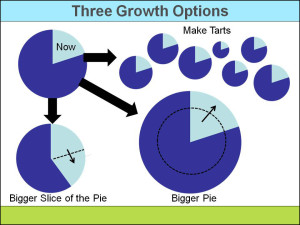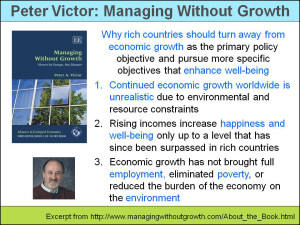An Elephant in the Sustainability Room: Growth

In today’s business model, growth is a given—an imperative. “Grow or die” is the undisputed maxim of business leaders. The stock market punishes companies that do not meet growth expectations. Growth is good. However, continuous growth appears to be at odds with sustainability principles. Growth is the ‘un-discussable’ elephant in the board rooms of companies aspiring to a sustainable business model.
So let’s make it discussable. Since growth is synonymous with progress and with winning in the game of business, we need to show how sustainability strategies are relevant and support companies’ growth goals. Yet we know that continuous growth is inherently unsustainable, given the finite carrying capacity of the planet. In nature, continuous growth is called cancer. In fact, passionate, principled champions of sustainability find it repugnant to suggest they should help companies grow since it is against their core values to do so. That’s why some shy away from the “sustainable development” label—development implies growth, and growth is unsustainable. Ergo, “sustainable development” is an oxymoron.
I suggest three strategies to work through this dilemma, while protecting our integrity as sustainability champions.
1. Bigger slice of the pie
We want leading sustainable companies to win. As described in my August 10, 2010 blog, sustainable firms disconnect revenue growth from depletion of natural resources—they drastically reduce the amount of natural resources required to make their products. They disconnect revenue growth from waste and pollution—they take back their products at the end of their useful lives and ensure they are responsibly disposed of or reused. They treat all internal and external stakeholders with respect. We want them to take market share away from unsustainable companies. If leadng sustainable companies grow by increasing their share of existing markets while reducing their ecological and social footprints, their growth is a good step in the right direction. At least it’s better than growth of their more unsustainable competitors.
2. Bigger pieResearch on ‘green growth’, suggests that benefits include the creation of new technologies, new jobs, and reduction of poverty and pollution. Suppose responsible corporate citizens could extend their reach—grow—into new adjacent or remote markets, especially the underserved markets of the world. Suppose green companies adopted local marketing, packaging, and ownership models to suit local norms, helping people to improve their quality of life as a co-benefit. Would that contribute to a more sustainable world? Yes.
Would that mean the company becomes bigger? Yes. Again, it feels like that kind of growth would be good thing—sustainable for a while, anyway.
3. Make tarts
A company can also grow its revenue by creatively supplementing its current product revenue with associated service revenue streams. It can lease its products instead of selling them and take them back at the end of their useful lives to recycle their components. It can start new companies with new forms of local ownership, collaborative partnerships, and new business models. It can clone itself in new markets or reinvent itself to better adapt to new market conditions in existing markets. It can broaden its subsidiaries’ customer bases through smart new, more sustainable products and services. It can become a network of sustainable companies and thrive on its multiple revenue streams. It can create new, more sustainable growth opportunities through its innovative offspring.
The fundamental growth rationalization is that sustainable companies nudge unsustainable competitors off the playing field. That’s a good thing. However, at some point even continuous growth of more sustainable companies will become challenging. The planet cannot sustain the growing demand for its non-renewable resources, nor keep up with absorbing more and more waste. Unless companies are completely resource-neutral, energy-neutral, and water-neutral, and produce zero-waste and zero-pollution, at some point their continuous growth becomes unsustainable. We’ll run out of “pie” and overshoot the carrying capacity of the planet to produce so much stuff and handle its associated waste.
‘Prosperity Without Growth’ was the title of a report published last year by the Sustainable Development Commission. Its title encapsulates the problem and it offers creative options. Peter Victor’s book, Managing without Growth, shows how an economy can perform well without traditional growth assumptions, while improving our quality of life. Both documents provide helpful food for thought.
Economic growth depends on consumer demand. A second undiscussable elephant in the board rooms of companies aspiring to a sustainable business model is consumption. More on that next week …
Bob
The PowerPoint slides used above are from my Master Slide Set.
Please feel free to add your comments and questions using the Comment link below.






Comments are closed.